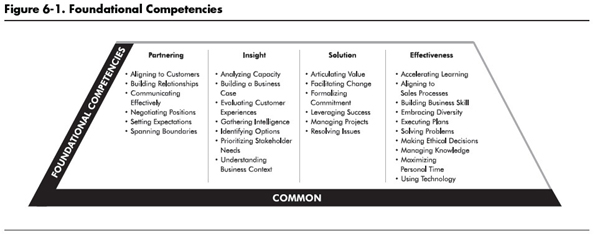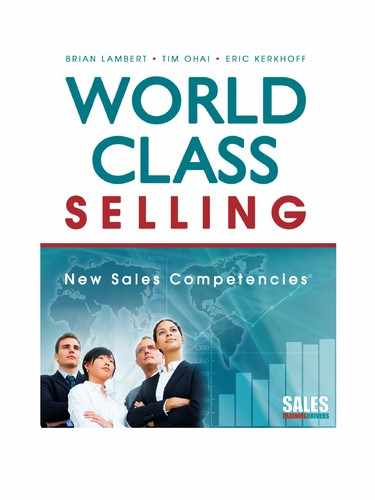Chapter 6
Foundational Competencies
Avoid competency traps. Do not stay only where you are good at things, go out and be challenged.
—Andrew Creighton
![]()
In this chapter:
- Understand the competency groupings used in the ASTD World-Class Sales Competency Model.
- Learn how foundational competencies apply to all sales professionals, regardless of the job title they hold.
- Discover the 10 most important foundational competencies in the ASTD World-Class Sales Competency Model.
Competencies are the basic building blocks of a competency model. In this case, they form the foundation of the pyramid that graphically represents the model. The foundational competencies identified in the ASTD World-Class Sales Competency Model are common, core, and critical to all sales professionals regardless of job title. They are also applicable to all roles within the model (see chapter 4).
It is important to understand that competencies are the clusters of skills, knowledge, abilities, and behaviors required for job success. Competencies are required for sales professionals to achieve world-class results. They also have many applications for organizations and individuals. Organizations can use competencies to define selection criteria for new hires or placements on the sales team and to guide their training and development. Employees can use competencies as a roadmap to their own success on the job—and sales professionals can use the ASTD World-Class Sales Competency Model to guide the training and development of sales team members.
The ASTD 2008 World-Class Sales Competency Study identified 29 foundational competencies as common, core, and critical to all sales professionals, regardless of role (see figure 6-1). These 29 foundational competencies cluster into four categories, logical groupings that help sales team members define and assess their level of competence. Each competency contains a list of key actions (see Appendix A).

The competency clusters are:
Partnering competencies. These competencies enable the effective creation and leveraging of relationships within the sales context and facilitate sales interactions. This cluster includes
- Aligning to customers
- Building relationships
- Communicating effectively
- Negotiating positions
- Setting expectations
- Spanning boundaries.
Insight competencies. These competencies enable the development of robust analysis and synthesis skills. They permit sales team members to use information effectively and efficiently. This cluster includes
- Analyzing capacity
- Building a business case
- Evaluating customer experiences
- Gathering intelligence
- Identifying options
- Prioritizing stakeholder needs
- Understanding business context.
Solution competencies. These competencies enable the effective development of strategies and generation of support for the resulting solutions. This cluster includes
- Articulating value
- Facilitating change
- Formalizing commitment
- Leveraging success
- Managing projects
- Resolving issues.
Effectiveness competencies. These competencies enable the demonstration and development of personal effectiveness and responsibility. This cluster includes
- Accelerating learning
- Aligning to sales processes
- Building business skill
- Embracing diversity
- Executing plans
- Solving problems
- Making ethical decisions
- Managing knowledge
- Maximizing personal time
- Using technology.
Defining the Relevant Behaviors
Foundational competencies define the relevant behaviors for all sales professionals. To varying degrees, everyone in the sales organization must display some aspect of each competency. For example, it is difficult to imagine any salesperson being successful without the ability to articulate value or solve problems. However, the way these competencies are used can depend on the particular job held by the salesperson.
The following illustrations show how the foundational competency, prioritizing stakeholder needs, has relevance for both a sales manager and a sales trainer:
Sales manager: Sales managers often are charged with making resource decisions, deciding when to spend money and on what. They must prioritize stakeholder needs to decide which expenditures must be made to meet sales or business goals and whether expenditures can be delayed. For example, an outside sales team might request new mobile technology at the same time sales support staff is requesting new customer relationship management (CRM) software.
Sales trainer: Sales trainers are often responsible for evaluating training requests and deciding which to handle first in an environment of tight staffing and fiscal responsibility. They must prioritize stakeholder needs to decide which requests will result immediately in a new customized learning program, which might be answered with off-the-shelf materials or external courses, and which must be tabled until further resources become available.
Although the competencies in the ASTD World-Class Sales Competency Model are foundational, few sales professionals will be strong in every one. Because all sales team members—regardless of level or experience—have unique strengths and development needs relative to the overall competency profile, it is impossible to construct a model that applies perfectly to everyone. Instead, the model is designed to cover most of the relevant skills and knowledge areas for a large majority of people in the sales organization.
The Top 10 Foundational Competencies
What does the data say about the top 10 foundational competencies, regardless of their position within each of the competency areas? Remembering that the foundational competencies apply to all roles in the sales profession, clearly partnering is the key. As shown in table 6-1, the partnering competencies of building relationships, communicating effectively, and aligning to customers were ranked as the top three in importance by survey respondents.
Selecting the right sales training partner is a monumental challenge for corporate training organizations. Millions are wasted every year because many sales training buyers do not have a complete understanding of the competencies required for sales jobs within their companies, the gaps that exist among sales personnel, and the capabilities of alternative vendors to close those gaps. World-Class Selling: New Sales Competencies will go a long way in helping buyers and sellers of outsourced sales training to close those gaps—a job that MUST be done.
—Dave Stein, president, ES Research Group
Quick Check
How important are the top 10 competencies to you and your organization? More important, how well is each competency addressed in sales training and supported by ongoing learning and development?
| Competency | Who Needs It? (salespeople, trainers, managers, sales operations) | Who Receives Training Support? |
• Building Relationships • Communicating Effectively • Aligning to Customers • Facilitating Change • Negotiating Positions • Setting Expectations • Executing Plans • Aligning to Sales Processes • Making Ethical Decisions • Maximizing Personal Time |
How is each competency identified above delivered to sales professionals? Is there only one group receiving this type of support? What about the other individuals within the sales profession, such as trainers, operations staff, recruiters, sales managers, and salespeople?
| Table 6-1. The Top 10 Foundational Competencies |
| Category | Competency | |
| Partnering | Building Relationships | 4.43 |
| Partnering | Communicating Effectively | 4.38 |
| Partnering | Aligning to Customers | 4.36 |
| Solution | Facilitating Change | 4.26 |
| Partnering | Negotiating Positions | 4.19 |
| Partnering | Setting Expectations | 4.17 |
| Effectiveness | Executing Plans | 4.16 |
| Effectiveness | Aligning to Sales Processes | 4.16 |
| Effectiveness | Making Ethical Decisions | 4.14 |
| Effectiveness | Maximizing Personal Time | 4.13 |
What Is Important?
So what do the data tell us regarding importance? In a ranking of overall importance, partnering and effectiveness competencies appear at the top of the list. Survey respondents rated each competency in terms of its importance for effectiveness in their current job. Table 6-2 shows the average current importance rating for all 29 competencies, grouped by category (partnering, insight, solution, and effectiveness) and appearing in descending order of importance. All of the competencies are more than moderately important (that is, rated 3.0 or above), and no single competency is dramatically more important than the others.
| Table 6-2. Foundational Competencies Ranked by Category |
| Category | Competency | |
| Partnering | Building Relationships | 4.43 |
| Communicating Effectively | 4.38 | |
| Aligning to Customers | 4.36 | |
| Negotiating Positions | 4.19 | |
| Setting Expectations | 4.17 | |
| Spanning Boundaries | 4.04 | |
| Partnering Competencies Average | 4.26 | |
| Insight | Prioritizing Stakeholder Needs | 4.07 |
| Identifying Options | 4.03 | |
| Evaluating Customer Experiences | 4.00 | |
| Gathering Intelligence | 3.99 | |
| Understanding the Business Context | 3.98 | |
| Building a Business Case | 3.88 | |
| Analyzing Organizational Capacity | 3.88 | |
| Insight Competencies Average | 3.98 | |
| Solution | Facilitating Change | 4.26 |
| Leveraging Success | 4.10 | |
| Formalizing Commitment | 4.08 | |
| Managing Projects | 4.05 | |
| Articulating Value | 4.04 | |
| Resolving Issues | 4.02 | |
| Solution Competencies Average | 4.09 | |
| Effectiveness | Executing Plans | 4.16 |
| Aligning to Sales Processes | 4.16 | |
| Making Ethical Decisions | 4.14 | |
| Maximizing Personal Time | 4.13 | |
| Accelerating Learning | 4.12 | |
| Embracing Diversity | 4.06 | |
| Managing Knowledge | 4.06 | |
| Solving Problems | 4.04 | |
| Using Technology | 3.97 | |
| Building Business Skill | 3.88 | |
| Effectiveness Competencies Average | 4.07 |
The ranking of the competencies is relatively stable and shows few differences in importance across organizational level (for example, executive or salesperson); area of expertise (for example, coaching or managing); or industry (for example, consulting or manufacturing). Additional analyses show that the importance of the competencies is unaffected by age, race, gender, or national origin.
In the Next Chapter
The final chapter in this book, chapter 7, is a call to action. It tells you how to assess whether your organizational culture is ready and receptive to implementing the ASTD World-Class Sales Competency Model. It shows you how to use the model as a blueprint for success and describes how a competency-based approach to selling works. You will find helpful tips for change management, as well as a personal charge to take responsibility for embracing your own learning and professional growth.
